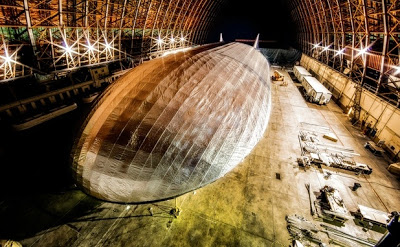

| Visitors Now: | |
| Total Visits: | |
| Total Stories: |

| Story Views | |
| Now: | |
| Last Hour: | |
| Last 24 Hours: | |
| Total: | |
Aeros Rigid Airship in Final Stages of Assembly
From
Aviation Week – A revolutionary aircraft prototype is now in the final stages of assembly and integration in a World War II airship hangar in Tustin, Calif. Developed by Aeros Corp., a California start-up, and funded by the Defense Department as a potential long-range transportation technology, the Pelican combines buoyant and aerodynamic lift in a different way from other lighter-than-air and hybrid vehicles, and is designed to be more efficient, more flexible and easier to handle on the ground. Its designers think that it could be evolved quickly into a vehicle with a C-17-like payload and range, combined with vertical-takeoff-and-landing (VTOL) capability.
Pelican is 230 ft. long and has a hull volume of 600,000 cu. ft. The primary structure comprises triangular-section carbon-fiber trusses that carry the engines—automotive diesels with thrust-vectoring propellers—the control surfaces and cockpit, and carry the lift loads from the gas cells. Curved secondary frames support an airfoil-contoured outer shell.
The next step, Pasternak says, is a vehicle with approximately twice the Pelican's overall dimensions and eight times the volume—about 450 ft. long and 3.8 million cu. ft.—capable of carrying a 66-ton payload over a 3,000-nm unrefueled range, and with combined diesel and turboprop propulsion. It could also incorporate the ability to superheat helium gas for takeoff—after takeoff, the helium would be allowed to cool to ambient temperatures and the vehicle would use a combination of aerodynamic and buoyant lift in the cruise, at speeds up to 80-100 kt. and up to 10,000 ft. Aeros has also experimented with techniques for extracting water from the engine exhaust to compensate for fuel use. “We could complete the design-build cycle on that vehicle in 28-30 months,” he tells Aviation Week.
Larger vehicles are possible in the future, says Pasternak, “but we strongly understand the need to test an operational vehicle before going to 100 or 200 tons.” So far, the 66-ton vehicle is unfunded.
17 months ago Nextbigfuture covered Aeros funding by the Pentagon for test rig.
The airship will be over three times as efficient as a C17 cargo ship but three times less efficient than a truck. It will be about three times faster than a truck (especially being able to fly in a straight line and over rough terrain).
C17 plane ton-mile per gallon 7 Aeros Airship Ton-Mile per Gallon of Fuel 23 Rail fuel efficiency (Ton-mile per gallon) 156 to 512 Trucks 68 to 133
LA Times – The Aeroscraft is being built under a contract of around $35 million from the Pentagon and NASA
See more and subscribe to NextBigFuture at 2012-10-19 15:23:25 Source: http://nextbigfuture.com/2012/10/aeros-rigid-airship-in-final-stages-of.html
Source:



